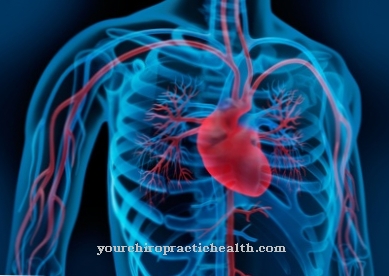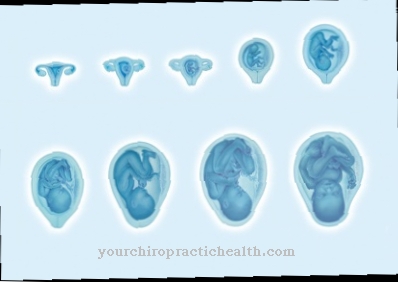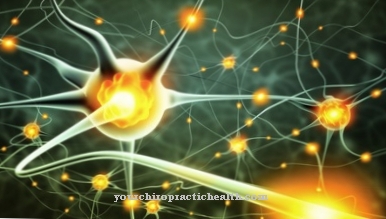As protopathic sensitivity will the Gross perception referred to as the sensory quality of the skin, which recognizes threats to the vital sphere. In addition to pain and temperature, humans perceive mechanical stimuli that migrate to the central nervous system via the spinothalamic tract. Associated complaints often arise from multiple sclerosis.
What is Protopathic Sensitivity?

The sensitivity can be further subdivided according to the type of stimulus, the location of the excitation, the centripetal transmission and the interconnection in different core areas. The latter group includes protopathic, epicritical and proprioceptive sensitivity.
The protopathic sensitivity is also known as coarse perception and encompasses all skin sensory perceptions that reveal a threat to the vital sphere. These include nociception, thermal reception and the coarser mechanoreception. Nociception corresponds to the perception of pain, thermoreception corresponds to the perception of temperature and mechanoreception corresponds to the perception of mechanical stimuli such as pressure.
The sensory cells involved in the skin are either nociceptors, mechanoreceptors or thermoreceptors. These sensory cells are open nerve endings that pick up a stimulus and convert it into bioelectrical excitation. They translate the threat to the vital sphere into the language of the central nervous system. The receptors only form an action potential when a certain stimulus threshold is exceeded.
Function & task
The sense of skin or touch is one of five sensory systems in the human organism. Thanks to the skin, people are sensitive to external stimuli such as pressure, touch, temperature and pain. In connection with the skin, a distinction is made between active and passive sensory qualities. The active qualities play a role in touching and are known as the sense of touch. The passive qualities come under the term tactile.
In addition to fine perception, the skin is capable of coarse perception. The fine perception corresponds to the tactile acuity and thus the epicritical sensitivity, as it is decisive for the active competencies of the skin senses. In contrast, the rough perception of the skin allows the human brain to recognize the threat to its own vital sphere and plays a role in the passive qualities of the system.
Pain, temperature and mechanical stimuli can be tolerated up to a certain threshold. Above this threshold, the body recognizes them as a clear threat. The transmission of all protopathic information is then done by the spinothalamic tract. The fiber bundles of this afferent nerve correspond to the lateral spinothalamic tract for pain perception and temperature perception and the anterior spinothalamic tract for the perception of coarse touch and tactile impressions.
The afferents of the spinothalamic tract cross the anterior alba commissure immediately after entering the spinal cord and shift to the contralateral side. Protopathic impressions are polyneuronally interconnected. The first neuron of the circuit is in the dorsal root ganglion. The second neuron is located in the posterior horn of the spinal cord. Immediately after switching from the first to the second neuron, the afference crosses to the contralateral side. On this side, the path of the anterior strand runs into the brain stem.
As the lemniscus spinalis, the path continues to the thalamus. The switchover to the third neuron takes place in its posterolateral ventral nucleus. The axons of this third neuron run through the internal capsule to the cerebral cortex (cortex cerebri). A fourth switch takes place in the sensory cortex (postcentral gyrus), which is used for conscious perception.
By far not all protopathic information is consciously perceived. The brain would be overloaded by the overstimulation. This is probably why the protopathic receptors only generate an action potential for transmission to consciousness above a certain threshold.
You can find your medication here
➔ Medicines against redness and eczemaIllnesses & ailments
Neurology deals with lesions of the protopathic pathways. In most cases, these are lesions of the lateral and anterior spinothalamic tracts. Isolated lesions of the anterior or lateral tracts are almost impossible because of the close spatial relationship. If one of the pathways is damaged, all impressions of the protopathic perception are almost always lost. In individual cases, the perceptions are only very limited. The position of the lesion can be at any height between the first and fourth neurons.
Irrespective of this, the deficits in protopathic perception can only be identified on the assigned side of the body of the first neuron. The sense of touch is not necessarily impaired in lesions of this type. Although the superordinate instance of the skin sense is capable of both active touching and passive sensation of impressions, lesions of the skin sense can differ depending on their location in the central nervous system.
The active perceptual qualities of the skin correspond to the epicritical sensitivity. This fine perception is interconnected in a different way than the protopathic sensitivity. In individual cases, lesions can nevertheless impair both sensory qualities.
A disease with both protopathic and epicritic lesions is multiple sclerosis (MS). The autoimmune disease causes immunological inflammation in central nervous tissue and can leave permanent damage. Protopathic abnormal sensations are a common early symptom of the disease. For example, an MS patient may perceive cold water as scalding hot and the same may be true vice versa. The simplest touch can be perceived as painful after MS-related lesions in the central nervous system. A feeling of heaviness in the limbs can also be imagined in connection with proprioceptive perception.
MS is not the only neurological disease that affects protopathic cognition. Nonetheless, it is one of the most common diseases with protopathic impairment.



























